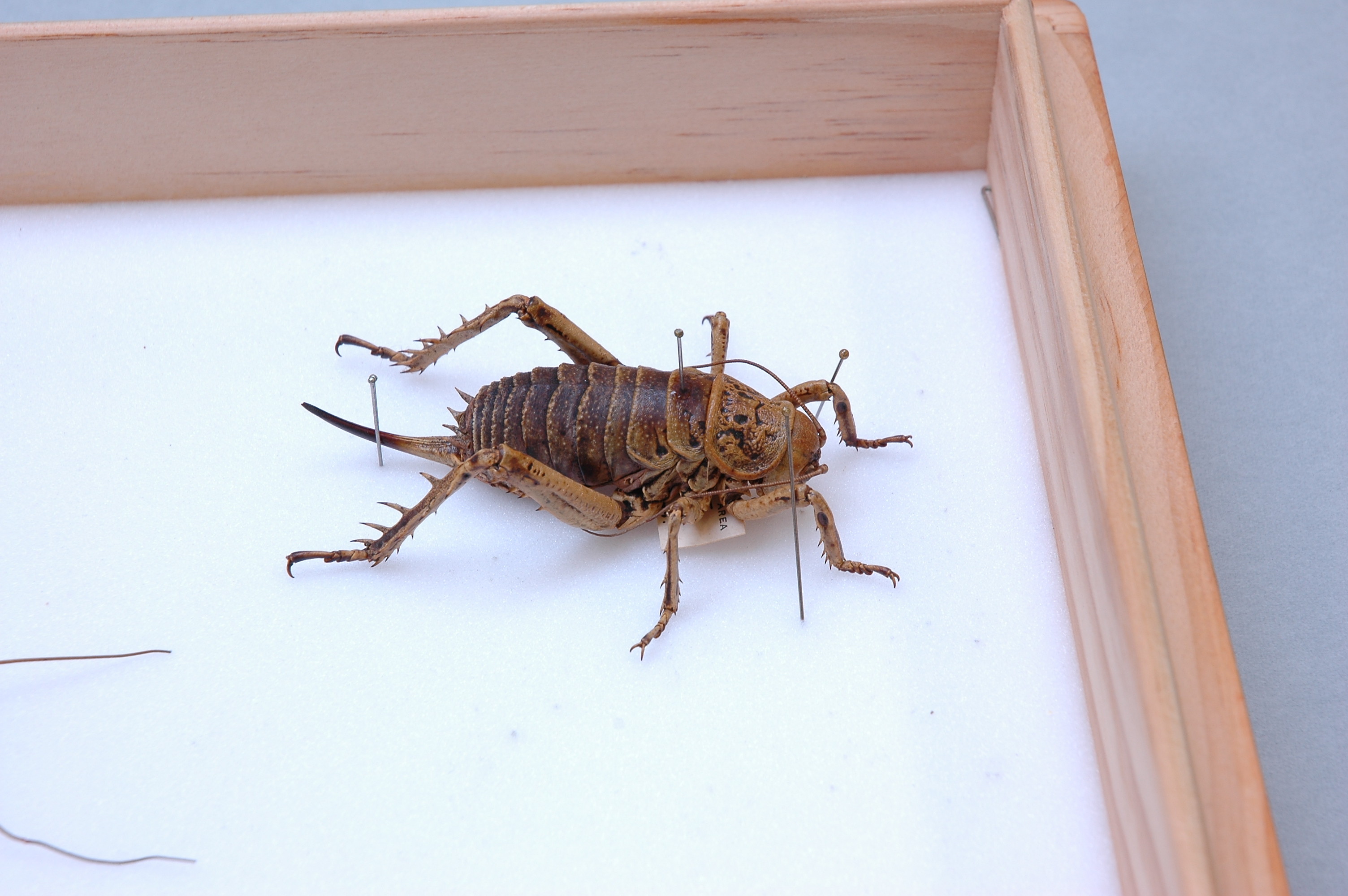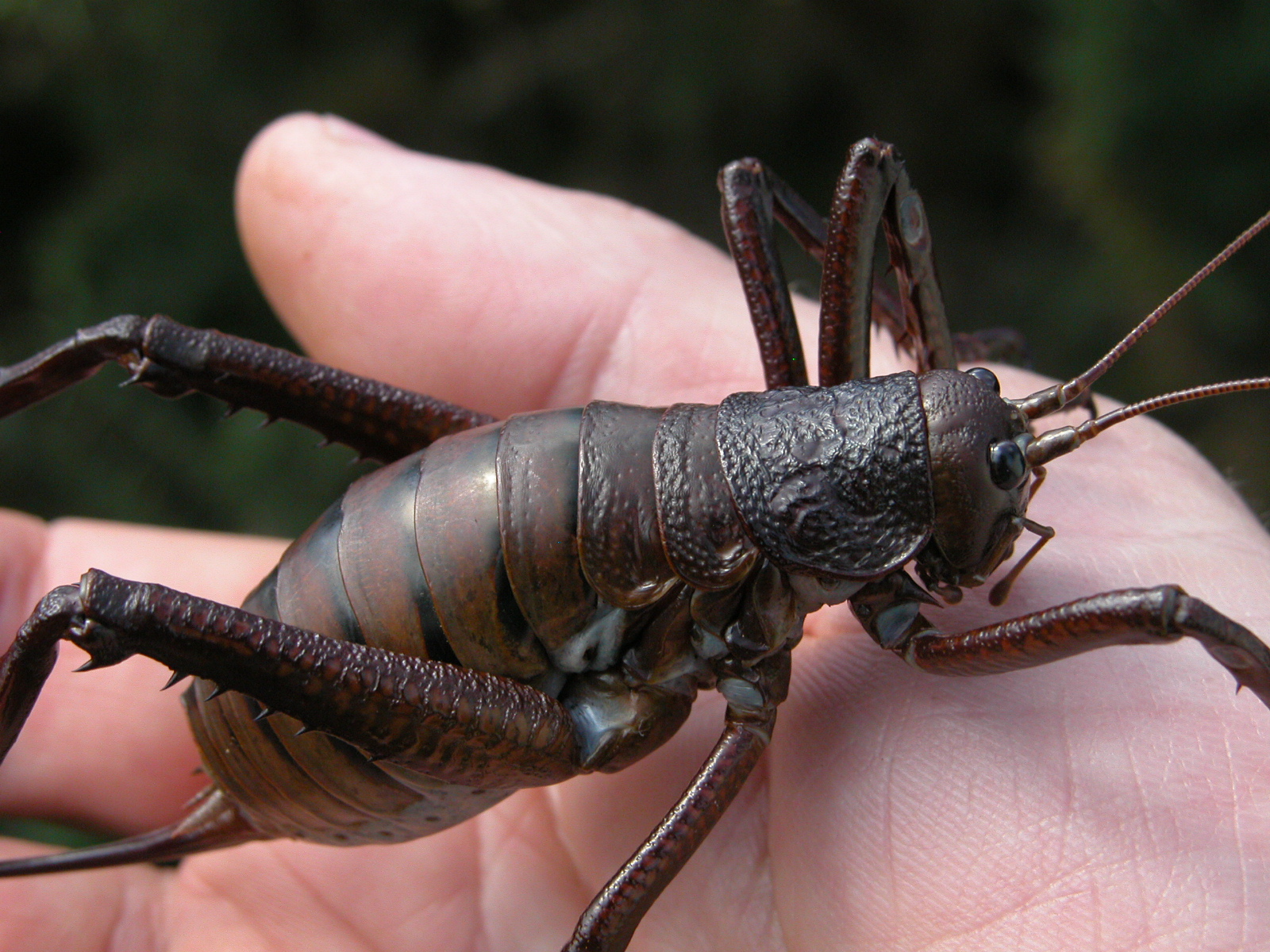|
Giant Wētā
Giant wētā are several species of wētā in the genus ''Deinacrida'' of the family Anostostomatidae. Giant wētā are endemic to New Zealand and all but one species are protected by law because they are considered at risk of extinction. There are eleven species of giant wētā, most of which are larger than other wētā, despite the latter also being large by insect standards. Large species can be up to , not inclusive of legs and antennae, with body mass usually no more than . One gravid captive female reached a mass of about , making it one of the heaviest insects in the world and heavier than a sparrow. This is, however, abnormal, as this individual was unmated and retained an abnormal number of eggs. The largest species of giant wētā is the Little Barrier Island giant wētā, also known as the wētāpunga. One example reported in 2011 weighed . Giant wētā tend to be less social and more passive than other wētā. Their genus name, ''Deinacrida'', means "terrible gr ... [...More Info...] [...Related Items...] OR: [Wikipedia] [Google] [Baidu] |
Deinacrida Heteracantha
''Deinacrida heteracantha'', also known as the ''Little Barrier giant wētā'' or ''wētāpunga'' (Maori: ''wētāpunga''), is a wētā in the order Orthoptera and family Anostostomatidae. It is endemic to New Zealand, where it survived only on Little Barrier Island, although it has been translocated to some other predator-free island conservation areas. This very large flightless wētā mainly feeds at night, but is also active during the day, when it can be found above ground in vegetation. It has been classified as vulnerable by the IUCN due to ongoing population declines and restricted distribution. Description ''D. heteracantha'' can weigh up to 70 g, but on average weighs between 9–35 g. Average body length is around 75 mm (3 inches).Nasrecki, P. 2013. Grasshoppers and their relatives. Elsevier Inc. 3: 247-264.Field, L.H. 2001. The Biology of Wetas, King Crickets and their Allies. New York: CABI Publishing. It is a sexually dimorphic species, with the females being ... [...More Info...] [...Related Items...] OR: [Wikipedia] [Google] [Baidu] |
Habitat Destruction
Habitat destruction (also termed habitat loss and habitat reduction) is the process by which a natural habitat becomes incapable of supporting its native species. The organisms that previously inhabited the site are displaced or dead, thereby reducing biodiversity and species abundance. Habitat destruction is the leading cause of biodiversity loss. Fragmentation and loss of habitat have become one of the most important topics of research in ecology as they are major threats to the survival of endangered species. Activities such as harvesting natural resources, industrial production and urbanization are human contributions to habitat destruction. Pressure from agriculture is the principal human cause. Some others include mining, logging, trawling, and urban sprawl. Habitat destruction is currently considered the primary cause of species extinction worldwide. Environmental factors can contribute to habitat destruction more indirectly. Geological processes, climate change, introdu ... [...More Info...] [...Related Items...] OR: [Wikipedia] [Google] [Baidu] |
Deinacrida Tibiospina
''Deinacrida tibiospina,'' also known as the Mt Arthur giant wētāAnker, Alison. (2010). The use of tracking tunnels to monitor the Mt Arthur giant weta (''Deinacrida tibiospina''). Wildlife Management Report: 236. University of Otago: Dunedin or the Nelson alpine giant wētā, is a species of wētā in the family Anostostomatidae. It is endemic to the South Island of New Zealand. The wētā is only found in some alpine zones of Kahurangi National Park. Compared with natural densities of other wētā, ''D. tibiospina'' is fairly rare. Little conservation effort has been made for this species because, despite its elusiveness, populations on the mainland have been maintained without human intervention. Description As one of the smallest known species of giant wētā, ''Deinacrida tibiospina'' grows to only around 30-40mm long, and weigh just 7 grams. Like many other giant wētā, such as ''Deinacrida rugosa,'' the overlapping armoured plates on their back are wrinkled. Adults ... [...More Info...] [...Related Items...] OR: [Wikipedia] [Google] [Baidu] |
Deinacrida Talpa
''Deinacrida talpa'', the giant mole weta, is a species of insect in the family Anostostomatidae. It is endemic to New Zealand. Although the species is similar to closely related species, its key distinguishing factor is their ability to live in burrows dug by the weta.Gibbs, G. W. 1999. Four new species of giant weta,Deinacrida(Orthoptera: Anostostomatidae: aaaDeinacridinae) from New Zealand. Journal of the Royal Society of New Zealand 29:307–324. The Department of Conservation An environmental ministry is a national or subnational government agency politically responsible for the environment and/or natural resources. Various other names are commonly used to identify such agencies, such as Ministry of the Environment ... assessed its status as "At Risk: Naturally Uncommon". References Wētā Anostostomatidae Insects described in 1999 {{anostostomatidae-stub ... [...More Info...] [...Related Items...] OR: [Wikipedia] [Google] [Baidu] |
Deinacrida Rugosa
''Deinacrida rugosa'', commonly called the Cook Strait giant weta or Stephens Island weta, is a species of insect in the family Anostostomatidae. The scientific name ''Deinacrida'' means "terrible grasshopper" and ''rugosa'' means "wrinkled". It is endemic to New Zealand. Description The Cook Strait giant weta is one of the largest insects in the world, reaching up to long. The brownish-yellow body is bulky and heavily armoured, with the upper surface covered by a series of thickened, overlapping plates, which have black markings. Relative to the size of the head, the jaws are large, and the elongated hind legs have five or six large spines, and can be raised above the head in defence. The female is significantly larger than the male, and both sexes lack wings.''Deinacrida rugosa'' ... [...More Info...] [...Related Items...] OR: [Wikipedia] [Google] [Baidu] |
Deinacrida Pluvialis
''Deinacrida pluvialis'' is a species of insect in family Anostostomatidae. It is endemic to New Zealand New Zealand ( mi, Aotearoa ) is an island country in the southwestern Pacific Ocean. It consists of two main landmasses—the North Island () and the South Island ()—and over 700 smaller islands. It is the sixth-largest island count .... References Wētā Anostostomatidae Insects described in 1999 {{anostostomatidae-stub ... [...More Info...] [...Related Items...] OR: [Wikipedia] [Google] [Baidu] |
Deinacrida Mahoenui
''Deinacrida mahoenui'', the Mahoenui giant wētā, is a flightless insect in the giant wētā family Anostostomatidae. It is Endemism, endemic to the area of Mahoenui, New Zealand, and the world population for some time was restricted to a single patch of introduced Ulex europaeus, gorse on farmland. Description ''Deinacrida mahoenui'' is a very large flightless insect: females weigh up to and can be long, while males reach 12 g and 50 mm. Females can be distinguished by their size and their long egg-laying spikes or ovipositors. Uniquely amongst giant wētā, ''D. mahoenui'' has two colour morphs: mahogany brown (over two thirds of the population) and golden yellow (about 31%). A two-coloured female has even been found, having one side brown and the other yellow. Reproduction Female Mahoenui giant wētā lay 200–400 eggs in autumn, burying them about 25 mm deep into the soil with their ovipositor. The eggs are about 7 mm long, and take 10 months to ha ... [...More Info...] [...Related Items...] OR: [Wikipedia] [Google] [Baidu] |




